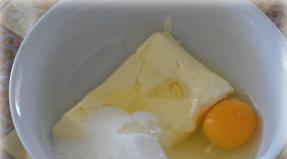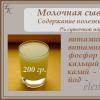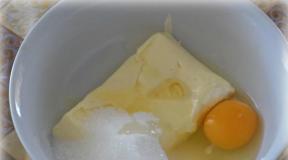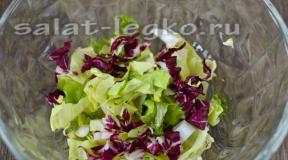How to normalize hemoglobin. How to increase hemoglobin at home quickly? Traditional medicine as an assistant for quickly reducing hemoglobin
Thank you
The site provides reference information for informational purposes only. Diagnosis and treatment of diseases must be carried out under the supervision of a specialist. All drugs have contraindications. Consultation with a specialist is required!
Question: "How to increase hemoglobin?" worries people who are faced with anemia. Anemia is a persistent, pathological decrease in the concentration of hemoglobin in the blood below normal limits.
It should be understood that the diagnosis of anemia is established on the basis of a laboratory analysis that reveals a decrease in hemoglobin concentration below normal for several times in a row. Typically, blood is donated 3–4 times every 4–7 days, and if each test reveals a decrease in hemoglobin concentration, a diagnosis of anemia is made. If a low hemoglobin concentration is detected in only one blood sample, and is normal in the rest, then we are talking about a functional disorder, not anemia.
Anemia can be combined with a reduced or normal number of red blood cells. That is, a low hemoglobin concentration is a mandatory symptom of anemia, and a decrease in the total number of red blood cells may or may not be present.
According to modern concepts, anemia is a pathological syndrome, and not an independent disease. Therefore, to treat it, it is necessary to find out the cause of the pathological decrease in hemoglobin concentration. You can begin treatment for anemia only after finding out the cause of its development, since the general treatment method depends on this.
The fact is that in addition to increasing hemoglobin with the help of various drugs, for successful treatment of anemia it is also necessary to eliminate the causative factor. It is the combination of methods aimed at increasing hemoglobin and eliminating the cause of anemia that is called complex treatment of the syndrome. After all, if the cause is not eliminated, then, despite the treatment to increase the level of hemoglobin in the blood, anemia will periodically return again, that is, recur.
However, in addition to eliminating the cause of anemia, the rest of the methods for increasing hemoglobin concentration are completely the same for different varieties of this pathological syndrome. Therefore, we will consider ways to increase hemoglobin that are suitable for any type of anemia. But when applying these methods, it should be remembered that they must be supplemented with treatment aimed at eliminating the causative factor of anemia.
Clinical classification of anemia - which types require an increase in hemoglobin
 The entire set of anemias, depending on the causative factor, is divided into four large categories:
The entire set of anemias, depending on the causative factor, is divided into four large categories: 1. Deficiency anemia associated with a lack or disturbances in the metabolism and utilization of iron, vitamins and other substances necessary for the process of hematopoiesis;
2. Posthemorrhagic anemia caused by blood loss as a result of acute or chronic bleeding;
3. Hemolytic anemia associated with increased destruction of red blood cells, caused either by hereditary diseases or the influence of negative factors, such as poisons, poisoning, radiation, long walking, etc.;
4. Hypoplastic anemia associated with bone marrow dysfunction.
Currently, the majority of anemias (80% to 85%) occurring in people belong to the class scarce. This group includes anemia caused by a deficiency of iron, vitamins B12, C and folic acid, copper and proteins necessary for the formation of heme. In addition, deficient ones include anemia that occurs against the background of severe chronic diseases of various organs and systems that impair metabolism and hemoglobin synthesis. Thus, deficiency anemia can be provoked by chronic pathologies of the kidneys or liver, any long-term infectious or inflammatory disease, hypothyroidism, malignant tumors, systemic lupus erythematosus and some other pathological processes.
The second place in frequency of occurrence is shared by posthemorrhagic and hemolytic anemia. Posthemorrhagic may be caused by immediate large blood loss resulting from injury, stroke, surgery or other action associated with vascular damage. Also, posthemorrhagic anemia can be triggered by chronic, long-term blood loss, for example, with bleeding from internal organs, heavy menstruation, etc.
Hemolytic anemia always associated with some factor causing rapid destruction of red blood cells. There is a small group of hereditary hemolytic anemias (for example, sickle cell, thalassemia, etc.), which are associated with a breakdown of the genetic apparatus and are passed on from generation to generation within the family. Such hereditary hemolytic anemias are rarely diagnosed and are treated only by a hematologist. However, in addition to hereditary ones, there are also acquired hemolytic anemias, which, as a rule, are provoked by exposure to some toxic factor, for example, salts of heavy metals, venoms of snakes, insects, mushrooms, etc., as well as long walking (marching anemia), alcohol poisoning , acids, alkalis, etc.
Hypoplastic anemia associated with impaired production of red blood cells in the bone marrow. Such anemias are severe, develop under the influence of various factors that damage the hematopoietic organs, and require serious replacement therapy, including bone marrow transplantation.
All types of anemia, with the exception of hypoplastic ones, require, as a complex therapy, an increase in hemoglobin in the blood and elimination of the causative factor. Eliminating the cause for posthemorrhagic anemia is to stop bleeding; for hemolytic anemia, it is to remove the factor that caused the breakdown of red blood cells; and for deficient anemia, it is to compensate for the lack of vitamins and microelements necessary for the production of hemoglobin. And the method of increasing hemoglobin for all of these types of anemia is the same and consists of stimulating hematopoiesis. Let's consider the general rules for increasing hemoglobin in various anemias.
How to increase hemoglobin - general rules
If hemoglobin has dropped below 60 mg/ml, then you should be hospitalized in a hospital for emergency measures to combat anemia. In such situations, doctors resort to blood transfusions, blood substitutes or red blood cells to increase the concentration of hemoglobin. After hemoglobin reaches 80–90 mg/ml, the transfusion of blood or its substitutes is stopped and the person is transferred to taking various medications that promote accelerated synthesis of red blood cells and heme, and, accordingly, eliminate anemia.In all other cases, increasing the level of hemoglobin in the blood is done at home by following a diet and taking various medications that replenish the body's need for microelements and vitamins necessary for hematopoiesis.
The general scheme for increasing hemoglobin in various types of anemia is as follows:
1.
Medical nutrition rich in vitamins and minerals;
2.
Taking iron, folic acid and vitamin B12 supplements;
3.
Treatment of existing chronic diseases.
Nutritional therapy for anemia is daily menu, containing foods rich in various minerals and vitamins, primarily iron, copper and B vitamins, especially B 12 and folic acid. The menu must include red meat (veal and beef), meat by-products (liver), legumes (beans, soybeans, lentils, peas, beans, etc.), dried fruits (raisins, prunes, dried apricots), herbs (spinach, parsley) , pomegranates, buckwheat porridge and whole grain bread. Daily consumption of these foods for anemia is mandatory, since they contain various microelements and vitamins necessary for the synthesis of hemoglobin, and therefore help increase its level in the blood. However, unfortunately, a therapeutic diet alone will not help increase the level of hemoglobin in the blood within an acceptable time frame (within 3 to 6 months), and therefore, in combination with it, a person must take iron, folic acid and cyanocobalamin supplements.
When following a special therapeutic diet, it is recommended to combine foods rich in iron compounds with vitamin C, since the latter improves the absorption and assimilation of iron. That is, buckwheat porridge It’s optimal to wash it down with orange juice, and the cutlet with lemon or tomato juice, etc. Since black tea reduces the absorption of iron from the intestines, it is recommended to either exclude it from the menu completely or drink it an hour before or after a meal. It is not recommended to use animal liver every day to increase hemoglobin, since in addition to iron it contains large amounts of vitamins A and D, which can cause an overdose. Doctors believe that it is optimal to consume liver 1–2 times a week as part of a therapeutic diet aimed at increasing hemoglobin. Such a well-known product as pomegranate juice really does an excellent job of increasing hemoglobin, but at the same time increases the risk of developing constipation, which should be kept in mind when including this product in your menu.
That is why to increase the level of hemoglobin in the blood it is necessary to take medicines iron, folic acid and cyanocobalamin. Moreover, in order to most quickly and effectively increase the level of hemoglobin in the blood, it is recommended to take cyanocobalamin (vitamin B 12), folic acid (vitamin B c or B 9), and iron supplements during the first 25 days. Then the intake of cyanocobalamin and folic acid is stopped and only iron supplements are left, which must be taken for 3 to 6 months. Depending on the severity of anemia and the speed of its correction, the doctor can select the optimal iron supplements, both in tablets and in the form of intravenous or intramuscular injections. In principle, doctors usually prescribe several injections of iron supplements to increase the level of hemoglobin in the blood as quickly as possible, followed by switching to taking tablet forms of the drug for a long period of time (at least three months).
How to increase hemoglobin at home
At home, you can increase hemoglobin in two ways - the first is taking iron, folic acid and cyanocobalamin supplements, and the second is therapeutic enhanced nutrition, which includes products containing elements and vitamins necessary for hematopoiesis and hemoglobin synthesis.Nutritional therapy is a completely possible way to increase hemoglobin at home, but it takes a very long time. It should be understood that the absorption of iron from food is no more than 3 - 5 mg per day, and therefore it will take a fairly long period of time to increase hemoglobin only with medical nutrition - at least 8 - 12 months.
From the point of view of modern methods, increasing hemoglobin only with therapeutic nutrition is irrational, since it takes too much time. That is why, in order to successfully and relatively quickly increase hemoglobin (within 3–6 months) at home, it is recommended, along with a therapeutic diet, to take tablet forms of medications containing iron. Currently, there is a wide range of different medications containing iron compounds, from which you can choose the best drug for yourself and take it according to the instructions at home for 3 to 6 months.
Unfortunately, there are no other “folk” methods for increasing hemoglobin at home. All miraculous recipes for decoctions and numerous potions are, in fact, just options for therapeutic nutrition, which, of course, increases hemoglobin in the blood, but does this for a very long time.
Foods that increase hemoglobin
All foods that increase hemoglobin
 Foods containing large amounts of iron, copper, folic acid and cyanocobalamin can increase hemoglobin levels. These products include the following:
Foods containing large amounts of iron, copper, folic acid and cyanocobalamin can increase hemoglobin levels. These products include the following: - Pistachios (60 mg);
- Pomegranate (40 – 50 mg);
- Dried mushrooms (30 – 35 mg);
- Boiled mussels or other shellfish (25 – 30 mg);
- Wheat bran (18 – 20 mg);
- Pork liver (18 – 20 mg);
- Brewer's yeast (16 – 19 mg of iron per 100 g of product);
- Sea kale (15 – 17 mg);
- Cocoa (12 – 14 mg);
- Spinach (12 – 14 mg);
- Lentils (11 – 13 mg);
- Veal or beef liver (9 – 11 mg);
- Peas (7 – 10 mg);
- Buckwheat (7 – 8 mg);
- Barley groats (7 – 8 mg);
- Egg yolk (6 – 8 mg);
- Heart (6 – 7 mg);
- Oatmeal (5 – 7 mg);
- Beans (5–6 mg);
- Peanuts (5 – 6 mg);
- Fresh mushrooms (5 – 6 mg);
- Beef tongue (5 – 6 mg);
- Rabbit meat (4 – 5 mg);
- Dogwood (4 – 5 mg);
- Almonds (4 – 5 mg);
- Peaches (4 – 4.5 mg);
- Turkey meat (3 – 5 mg);
- Cashew (3 – 5 mg);
- Wheat flour (3 – 3.5 mg);
- Walnut (2.8 – 3.0 mg);
- Pine nut (2.8 – 3.2 mg);
- Apricots (2.0 – 2.6 mg);
- Persimmon (2.5 mg);
- Apples (0.5 – 2.2 mg);
- Raspberries (1.6 – 1.8);
- Beetroot (1.0 – 1.4 mg);
- Boiled broccoli (1.0 – 1.2 mg);
- Pasta (1.0 – 1.2 mg);
- Semolina (1.0 – 1.2 mg);
- Honey (0.9 – 1.0 mg);
- Carrots (0.7 – 1.2 mg);
- Potatoes (0.8 – 1.0 mg);
- Prunes (0.9 – 1.3 mg);
- Dried apricots (0.96 – 1.4 mg);
- Corn (0.8 – 1.0 mg);
- Bananas (0.7 – 0.8 mg);
- Fried chicken (0.7 – 0.8 mg);
- Tomatoes (0.6 – 0.7 mg);
- Salad (0.5 – 0.6 mg);
- Egg white (0.2 – 0.3 mg);
- Pears (0.1 – 1.2 mg).
You should know that iron in fruits and vegetables is in a poorly digestible form, so even consuming them in large quantities does not provide the body with a sufficient amount of this element, and therefore does not increase hemoglobin. Iron in a highly digestible form is found only in products of animal origin (with the exception of eggs), so they must be included in the diet in order to increase the concentration of hemoglobin.
Fruits that increase hemoglobin
 Fruits that increase hemoglobin are fruits with the maximum content of iron compounds, folic acid and cyanocobalamin. Therefore, fruits and berries that increase hemoglobin include the following:
Fruits that increase hemoglobin are fruits with the maximum content of iron compounds, folic acid and cyanocobalamin. Therefore, fruits and berries that increase hemoglobin include the following: - Apricots;
- Bananas;
- Cherry;
- Pomegranate;
- Pears;
- Dogwood;
- Dried apricots;
- Peaches;
- Plums;
- Currant;
- Dates;
- Persimmon;
- Prunes;
Does pomegranate increase hemoglobin?
Yes, pomegranate really does an excellent job of increasing hemoglobin in the blood, but its frequent use causes constipation. Therefore, the inclusion of pomegranate in the daily menu should be approached carefully and carefully.Foods that increase hemoglobin during pregnancy
Foods that increase hemoglobin during pregnancy are exactly the same as for non-pregnant women, men and children. A pregnant woman can use all of them if she has no contraindications for any product.How to increase hemoglobin quickly
There is only one way to quickly increase hemoglobin - to make several intravenous or intramuscular injections of an iron preparation in combination with folic acid and cyanocobalamin. Usually, 2–3 injections of folic acid and cyanocobalamin are sufficient, as well as 1–2 intravenous or 2–3 intramuscular injections of iron supplements. Injection of vitamins and iron can quickly increase hemoglobin levels, but in the future, to achieve a lasting effect, it is necessary to continue taking iron supplements in tablet form.Another way to quickly increase the level of hemoglobin in the blood, used only in hospitals, is the transfusion of blood, blood substitutes or red blood cells. This method is used to quickly increase hemoglobin levels in a person who has lost a lot of blood due to injury, surgery, or bleeding.
How to increase hemoglobin during pregnancy, in infants and in children
Since infants, children and pregnant women have an increased need for microelements and vitamins, including iron, cyanocobalamin and folic acid, even with a slight deficiency in food they develop anemia. Since for pregnant women, infants and children, a deficiency of any element or vitamin, as well as anemia can be critical and negatively affect growth and development, it is necessary immediately after identifying a lack of iron in the blood to begin eliminating it and, accordingly, increasing the level of hemoglobin .In these categories of people, the level of hemoglobin in the blood should be increased exclusively with pharmaceutical preparations of iron, cyanocobalamin and folic acid, since a lack of microelement can lead to irreversible consequences. Pregnant women and children should take iron tablets for at least six months, and folic acid and cyanocobalamin for one month. To increase hemoglobin in infants, you will have to resort to intramuscular injections of iron preparations, produced in the form of solutions. To achieve a lasting effect, approximately 25–40 injections will be required.
Eating foods rich in iron for children and pregnant women does not replace taking specialized medications, but complements them. Remember that taking iron supplements without dieting can increase hemoglobin. But just by consuming foods rich in iron, without taking medications, it is almost impossible to increase hemoglobin.
When do children have low hemoglobin, and how to increase it - video
How to increase hemoglobin with medications (general rules)
To increase the level of hemoglobin in the blood with the help of medications, you must take the following types of drugs:- Iron preparations in tablet or injection form;
- Folic acid preparations in tablet form;
- Cyanocobalamin preparations in tablet or injection form.
Selection of dosage form iron supplement(tablets or injection solution) depends on the level of hemoglobin in the blood. If the hemoglobin concentration is below 70 mg/ml, then you should start with intramuscular or intravenous administration of iron supplements. When the hemoglobin concentration rises to 90 mg/ml or more, you can switch to taking iron tablets. If anemia was detected at a hemoglobin level of 90 mg/ml or higher, then to increase it, you can immediately take iron supplements in the form of tablets or syrups. It is recommended to use iron supplements in the following dosages:
- Tablets or syrups - take 200 mg 2 - 3 times a day;
- Solutions – administered intramuscularly or intravenously at 100–200 mg per day.
The total duration of taking iron supplements to increase hemoglobin is 3 – 6 months. After achieving the result (increasing hemoglobin to normal values), it is necessary to continue taking iron supplements 200 mg once a day for another 2 to 3 months to replenish the reserves of the microelement in the body. In the future, to prevent relapse of anemia, you should take iron supplements 200 mg once a day for a week at the beginning of each month for one year.
 Cyanocobalamin for the treatment of B 12-deficiency anemia, 1 mg is administered intramuscularly for 6 to 7 days. However, such a high dosage of cyanocobalamin may be poorly tolerated, and therefore practitioners prefer a different, longer treatment regimen in which vitamin B 12 is administered longer, but in smaller quantities. According to this scheme, cyanocobalamin is administered intramuscularly for 1 - 3 days, 100 mcg, and then for another 25 days - 200 - 400 mcg per day. After one episode of B 12-deficiency anemia, cyanocobalamin solutions are administered intramuscularly according to one of the indicated regimens once a year for life, to prevent relapse.
Cyanocobalamin for the treatment of B 12-deficiency anemia, 1 mg is administered intramuscularly for 6 to 7 days. However, such a high dosage of cyanocobalamin may be poorly tolerated, and therefore practitioners prefer a different, longer treatment regimen in which vitamin B 12 is administered longer, but in smaller quantities. According to this scheme, cyanocobalamin is administered intramuscularly for 1 - 3 days, 100 mcg, and then for another 25 days - 200 - 400 mcg per day. After one episode of B 12-deficiency anemia, cyanocobalamin solutions are administered intramuscularly according to one of the indicated regimens once a year for life, to prevent relapse.
Folic acid To increase hemoglobin, it is prescribed when cyanocobalamin injections are ineffective. It is recommended to take 5 mg once a day for several months. The end of treatment occurs when hemoglobin rises to normal values.
Drugs (medicines, medicines) that increase hemoglobin (list)
Currently, the domestic pharmaceutical market has a wide range of iron preparations that increase hemoglobin. These drugs are available in various dosage forms - tablets, syrups, capsules or drops for oral administration and solutions for injection. Here is a list of the most common and effective iron supplements in various dosage forms:Frequent weakness, rapid fatigue, absence, drowsiness, heart rhythm disturbances, low blood pressure are signs of decreased hemoglobin. Vitamins and normalization of nutrition help increase its level in the blood.
What is hemoglobin
Red blood cells contain erythrocytes that contain iron atoms.
In the body it takes various forms:
- the form combined with oxygen is called oxyhemoglobin, it gives arterial blood a bright red color;
- the so-called reduced form, when oxygen is delivered to the tissues;
- carboxyhemoglobin, a form combined with carbon dioxide, causing venous blood to acquire a dark tint.
The function of hemoglobin is to deliver oxygen from the lungs to the body's cells, bind carbon dioxide, and return it to the lungs.
Its increased content in the blood is typical for residents of high mountains, climbers, whose bodies are adapted to rarefied air, poor in oxygen. Thus, low hemoglobin is raised physical exercise, intense walk.
Normal in blood
The level of hemoglobin in the blood is determined by a complete blood count.
Normal values:
- for men 130-160g/l, lower limit 120, upper limit – 180g/l;
- for women 120-140 g/l, for pregnant women the lower limit of normal is 110 g/l;
- in children, indicators depend on age; up to 18 years of age they gradually rise to normal “adult” values.
Symptoms of low hemoglobin
Anemia (anemia) is not a disease, but a symptom of a health pathology, which is accompanied by a decrease in the number of red blood cells.
General signs of anemia:
- sleep disorder;
- rapid fatigue;
- excessive whiteness of the skin and mucous membranes, “blueness” of the lips;
- frequent dizziness;
- dyspnea;
- increased heart rate.
Before treatment and changing your diet, it is worth understanding the causes of low hemoglobin.
Causes of anemia
Iron deficiency. This type of anemia accompanies a perverted appetite. I want to eat earth, clay, paper, chalk, inhale the unpleasant pungent smells of gasoline, paints, and wet tobacco ash. The nails are brittle, concave, and the mucous membranes are inflamed. Dry skin, s. Hair falls out. Weakness of muscle fibers is the cause of voluntary urination. A characteristic symptom is increased sensitivity to cold, hands and feet are constantly freezing, frequent. Retarded growth and development of the child, lethargy, illness.
Folic acid (vitamin B9) deficiency as a result of intestinal surgery, long-term use of medications against seizures (Phenobarbital), alcohol abuse. In adults, increased fatigue, weakness, shortness of breath, rapid heartbeats, inflamed tongue, lack of appetite, pain or dizziness. Memory impairment, irritability, jaundice.
Hemoglobin levels increase after prolonged feeding of a child with goat's milk, which is low in vitamin B9. To prevent this type of anemia, replace infant formula and donor milk.
Deficiency of cyanocobalamin (vitamin B12). With this type of anemia, coordination of movements is impaired. Changed gait, stiffness, clumsiness. The sense of touch is impaired, false tingling of the skin. Bright red, “varnished” tongue. The condition requires an increase in hemoglobin.
Acute or chronic form of hemolytic anemia– a group of diseases associated with massive destruction of red blood cells. The body enhances their synthesis. Symptoms are similar to cholelithiasis: red or brown urine, yellowing of the skin and sclera of the eyes, delayed childhood development.
The exact cause of anemia is determined by a hematologist who treats diseases of the blood system. To make a diagnosis it is necessary to pass biochemical analysis blood.
Hemoglobin increases by adjusting the diet and taking vitamins.
Increased hemoglobin with iron deficiency
This type of anemia requires divalent heme iron, which is completely absorbed by the body. There is a lot of it in meat foods, kidneys and liver.
Plant foods contain trivalent non-heme iron - legumes, buckwheat, whole grains,.
To convert the trivalent form into the divalent form, vitamin C is needed; there is a lot of it in greens. Legumes are best combined with vegetables rich in vitamin C.
Raspberries are champions in iron content. Hemoglobin is increased by pork and beef liver, veal, spinach, buckwheat, wheat, rolled oats, pomegranates, prunes, plums, peaches, dried apricots, brewer's yeast, cocoa, seafood, baked potatoes with skin, and nuts.
Pomegranate juice increases hemoglobin, but is dangerous for constipation.
Do not consume iron-containing foods with, which slows down the absorption of iron. Refuse or reduce coffee, black tea, cheese.
How to increase hemoglobin with B9 deficiency
Plant-based eaters get enough. There is a lot of it in beef liver, legumes, citrus fruits, lettuce, cabbage, melons, watermelons, apples, green peas, rolled oats, buckwheat, yeast, cottage cheese, cheese, liver, egg yolk, grapes, pomegranates, apricots, black currants, kiwi , turnip.
If there is a sufficient intake of the listed products, folic acid is synthesized by the microflora of the large intestine - there is no need to increase hemoglobin.
Vitamin B9 is destroyed by sunlight and heat treatment.
Fresh legumes contain substances that prevent the breakdown of proteins and inhibit digestion. Eating sprouted legumes improves their absorption and helps avoid flatulence.
Sprouting wheat grain increases the content of folic acid and B vitamins 4 times. Only 50g of useful product contains daily norm vitamin B9.
Lack of folic acid is caused by excessive consumption of coffee, tea, smoking, and alcohol.
Vitamin B9 is necessary for, regulates the formation of nerve cells in the embryo, and helps increase hemoglobin. Folic acid is prescribed before conception and the course is continued after pregnancy.
Treatment of anemia due to B12 deficiency
If the cause of anemia is cobalamin deficiency, to increase hemoglobin, include veal or beef liver, oysters, herring, sardines, salmon, egg yolks, and soy products in the diet. less in pork, beef, chicken, hard cheese, seafood, milk, herbs and vegetables.
Include vitamin complexes in the diet to eliminate vitamin B12 deficiency and increase hemoglobin when plant foods predominate in the diet.
For better absorption of vitamin B12, calcium is needed, which is rich in dairy products.
The source of cyanocobalamin is beer shakes, ask at the pharmacy. Taking them restores the production of B12 in the intestines and increases hemoglobin.
Modified: 12/05/2019Hello dear readers. Low hemoglobin levels are a common phenomenon that everyone has heard about. But what if there is a deviation from the norm in the other direction. Is high hemoglobin in the blood dangerous? , and how to reduce its level to normal? An increase in hemoglobin in the blood can be prevented in most cases. To do this, it is recommended to adhere to a healthy, harmonious diet. Fresh air is also needed to prevent hypoxia, to which the body can react with an excess of red blood cells. Attention to your health, including the eradication of harmful addictions, and regular visits to the doctor, especially in the presence of chronic diseases, will also help avoid such deviations.
Normal hemoglobin - the concept of normal concentration
The normal hemoglobin level is a value that has a fairly wide range. It depends on various factors, including the person's age and gender;
For women this figure is normally 120-140 g per liter of blood;
IN gestation period there is usually a drop in hemoglobin levels due to blood thinning and due to the fetus pulling iron from the mother’s body; at this time this value may drop to 110 g/l;
U men hemoglobin is slightly higher - 130-160 g/l;
As for children's norm , then this indicator constantly changes in the process of growing up. At first it reaches its maximum level (from 145 to 225 g/l), and at the age of several months it becomes the lowest (falls to an average of 100 g/l).
Subsequently, hemoglobin gradually increases, reaching a completely established value by the age of 18 (according to gender).
The concept of glycohemoglobin and its norm
Red blood cells are red colored blood cells. This color is given to them by hemoglobin, a protein structure containing iron.
Red blood cells carry oxygen throughout the body. This happens due to hemoglobin. It is because of the presence of iron that they can attach oxygen and then detach it, delivering it to its destination. That is, these hemoglobin-oxygen structures (oxyhemoglobin) are reversible.
But hemoglobin can attach not only oxygen. It also interacts with carbon dioxide, delivering it from the organs to the lungs. This produces carbohemoglobin, which is also a reversible compound.
But hemoglobin can also bind to glucose, which is in the blood. This process is irreversible. As a result, a stable compound is formed - glycohemoglobin. Being in a bound state, such hemoglobin cannot perform its usual functions.
The amount of hemoglobin bound by glucose in a healthy body is not spontaneous, but rather strictly limited.
Glycohemoglobin level is a value indicating the percentage concentration of sugar in the blood for a certain period (up to three months). Therefore, this indicator should not be confused with the definition of “blood sugar level,” the number of which indicates the concentration of glucose at the moment.
Normally, glycated hemoglobin accounts for 4 to 6% of the total hemoglobin in the blood. This indicator does not depend on the patient’s gender or age. When this value reaches the upper threshold, we are talking about a prediabetic state, and a further increase indicates the presence of diabetes.
But an increase in the concentration of glycohemoglobin in the blood can be observed not only in diabetics. This occurs when metabolic processes are disrupted for various reasons:
- renal failure;
- damage to the spleen;
- consumption of alcoholic beverages;
- anemia, including hemolytic;
- high blood viscosity;
- ineffective fight against hyperglycemia;
- blood infusion or significant blood loss.
When glycohemoglobin is higher than normal, the patient experiences weakness, he begins to get tired quickly, which causes a decrease in performance.
The person is thirsty, has weakened vision and noticeable loss of body weight. Also in this state there is a slowdown in regeneration processes.
Reasons for increased hemoglobin in the blood in men and women
The amount of hemoglobin in the blood can be influenced by all sorts of factors, both external and internal.
- Environmental conditions. At low oxygen concentrations, which is typical for high mountain areas, the body switches to an enhanced operating mode. This leads to an increase in hemoglobin levels.
- Features of the profession. This factor is related to the previous one and is typical for pilots, flight attendants, installers, rock climbers, rescuers, etc. Also, a high level of hemoglobin is observed in professional athletes involved, for example, in wrestling, weightlifting, skiing, running and its variations.
- Excess carbon dioxide. It may be associated both with the characteristics of the work (workers in “harmful” industries, miners, etc.) and with living in places with high air pollution (industrial zones).
- Taking anabolic drugs. Anabolic steroids (including steroids) not only allow you to quickly produce muscle tissue and give the body a beautiful contour, but also cause a deterioration in overall health due to a sharp increase in the concentration of red blood cells and a jump in the hemoglobin level.
In addition to external reasons, internal factors can also lead to an increase in hemoglobin in adults, as well as in adolescent children:
- diabetes;
- heredity;
- cardiac, pulmonary or renal failure;
- problems with the gallbladder;
- bone marrow hyperactivity;
- cancerous tumors;
- poisoning;
- dehydration due to various reasons, including diseases, drinking disorders, physical labor in conditions high temperature;
— pregnancy (albeit in rare cases, the body can react to this condition anyway);
- hypervitaminization of the body (vit. B), excess iron, use of certain drugs.
In addition to those listed, there are also probabilistic factors. They can cause an increase in blood viscosity, and, consequently, an increase in hemoglobin levels in the blood, with some probability.
For example, overwork, exposure to stress, and nicotine addiction can lead to both a sharp increase in this indicator and a decrease in it.
Infants may experience an increase in blood viscosity due to oxygen starvation during fetal development. This occurs as a result of dysfunction of the placenta.
As a rule, this indicator gradually returns to normal with proper care. But there are times when a completely healthy baby shows signs of increased hemoglobin due to the parents’ misconception about the conditions that are comfortable for the child.
Excessive wrapping, warming, maintaining a high temperature in the children's room, and lack of ventilation lead to an overestimation of this parameter in the baby.
High hemoglobin - main symptoms
An increase in hemoglobin (hyperhemoglobinemia) can be detected using a blood test. But changes in blood viscosity also have external manifestations:
- general weakness and apathy, rapid fatigue;
- decreased attention, weakened memory;
— sleep disturbance, emotional swings;
- aching joints, muscle pain and headaches;
- loss of appetite (partial or complete);
- paleness of the fingertips;
- urination problems (increases frequency or becomes rare);
- yellow tint of the skin, itching; pigmentation of the palms and axillary area;
- yellowing of the palate, tongue, eye whites;
- feeling of thirst and dry mucous membranes;
- deterioration in vision clarity;
— change in pressure;
- Women may experience prolonged menstruation with severe pain.
As you can see, such symptoms can easily be confused with a number of other diseases. So, based on symptoms alone, it is extremely difficult to identify an excess of hemoglobin in the blood.
In most cases, the increase in hemoglobin is secondary. The primary condition here will be some kind of disease.
Consequences of increased blood viscosity
Increasing hemoglobin levels and increasing blood viscosity are interrelated concepts.
Moreover, either the concentration of protein bodies jumped, which means the blood became thicker, or the lack of fluid led to an increase in the thickness of the blood, which caused an increase in the degree of its saturation with hemoglobin structures.
These phenomena have a number of negative consequences for the body.
- Due to the high saturation of the blood with protein bodies, the likelihood of them sticking together increases. This is precisely the mechanism of thrombus formation.
- Thick blood moves more slowly through the vessels, which leads to the deposition of cholesterol and other “garbage” on the walls of the blood vessels. This leads to the formation of plaques and blockage of blood vessels.
- Too viscous blood requires a lot of effort to pump it. As a result, the load on the heart and the circulatory structures themselves increases sharply.
- Due to the low speed of blood movement, nutrition and gas exchange throughout the body deteriorate, and self-purification processes slow down. Poor blood circulation in the brain is fraught with mental disorders and many other complications.
- With long-term high levels of hemoglobin in children, developmental and growth disorders are observed.
Thus, increased hemoglobin in the blood of women and men can lead to congestion, heart attack, heart attacks, ischemia, and thrombosis.
These are serious disorders that are much easier to prevent than to try to cure. In addition, there is a considerable probability of death. It is enough for one large blood clot to simply break off and completely block the blood flow.
Ways to reduce elevated hemoglobin in the blood - treatment
It should be clearly understood that the problem of increased hemoglobin is really serious. Therefore, there is no place for self-diagnosis or self-medication here. All techniques, including the proposed diet, must be discussed with a specialist.
But there is no need to panic either. Especially if the indicator is insignificantly overestimated and there is a high probability that this is a temporary phenomenon.
In this case, no special actions, much less treatment, are needed. Everything will return to normal on its own. The main thing is to determine which factor caused the unwanted jump in order to remove it or at least minimize its influence.
You should also avoid eating foods containing iron and vit. Q9.
Taking iron-containing and complex vitamin preparations should be discontinued. But the doctor also makes similar conclusions. Perhaps taking vitamin supplements and folic acid will help solve the problem and normalize the condition.
Also, an increase in hemoglobin can be caused by some other medications.
Hemoglobin can increase:
— hormonal drugs, including contraceptives;
- sedatives;
- medications that constrict blood vessels and normalize blood pressure.
You should inform your doctor about taking these medications. They may need to be abandoned or replaced with other drugs that are more appropriate in the circumstances.
Drug treatment
You should know that there are no drugs that specifically target hemoglobin. The action of the drugs is aimed at thinning the blood and normalizing its clotting.
Commonly used:
Trental - thins the blood and reduces aggregation phenomena.
Aspirin – half a tablet a day is enough, contraindicated for gastrointestinal problems.
Cardiomagnyl - a drug based on aspirin, the composition also includes magnesium hydroxide, which eliminates the negative effect of the acidic component of the drug on the stomach.
Chimes – reduces thrombus formation, contraindicated in renal and heart failure and heart attack.
Warfarin – reduces coagulability, is prescribed in parallel with aspirin, has many contraindications.
These pharmacological agents are prescribed only by a doctor. Occasionally, a special procedure may be prescribed - erythrocytapheresis.
It allows you to filter out excess hemoglobin structures. A course of 3-5 procedures is prescribed, one per week.
In cases where the increase in hemoglobin indicator has jumped due to the presence or exacerbation of a disease, then all efforts should be focused on curing it.
If this root cause is not eliminated, then all actions to reduce hemoglobin may be ineffective. These matters are also within the “jurisdiction” of the doctor. Only he is responsible for prescribing and discontinuing medications, as well as monitoring the patient’s condition.
All changes in health, especially negative ones, and side effects from prescribed medications should be reported to your doctor.
Without this, it is impossible to correctly adjust the treatment regimen and obtain quick results.
Treatment with diet
A special dietary menu will help avoid further increases in hemoglobin levels. As already noted, foods high in iron and vitamin content should be excluded from the daily diet. B9 (folic acid).
The menu should not contain products such as:
- meat, eggs, liver, sausages;
- radishes, beets, berries and fruits colored red and yellow-orange (especially pomegranates, cranberries and apples);
- milk and milk products with high fat content;
— sweets, baked goods and sweet drinks, alcoholic products, beer, including non-alcoholic beer, cocoa products;
- buckwheat and rolled oats porridge;
- mushrooms, especially dried ones;
You should also be wary of products that contain food additives. It would be advisable to refrain from fried foods.
But what can you eat then?
Allowed dishes based on:
- lean fish and seafood (shrimp, mussels, squid);
— vegetables and fruits (green color) and juices;
— fermented milk products (cheese, kefir, sour cream), as well as cottage cheese;
- legumes;
— sauerkraut;
- greenery.
It would be a good idea to switch to a vegetarian diet during treatment.
Traditional medicine
Some folk remedies can be quite effective in dealing with the problem that has arisen.
- Hirudotherapy is the use of medicinal leeches. This method will ensure the drainage of excess blood, which will help reduce blood viscosity and the concentration of hemoglobin proteins. Carrying out the procedure requires the experienced hand of a specialist.
- Hijama is a method of bloodletting to get rid of “bad” blood or, as in this case, its excess. You should only seek help from specialized institutions where competent professionals work.
- Donation is another proven way to get rid of an excess of red blood cells, although it is not entirely “folk”. But this option is not suitable if you have certain diseases. People are not allowed to donate even if they are completely cured of some ailments. Moreover, the fact of their transfer does not have a statute of limitations.
- Mumiyo (mountain balsam) is a unique remedy that has a wide range of effects. It is recommended to use the tableted substance in a ten-day course of one tablet (0.2 g) per day. After a short break (several days), the treatment is repeated.
During treatment, regardless of whether a traditional or alternative approach is used, you should completely stop smoking and also not take alcoholic beverages or sedatives.
You also need to drink as much liquid as possible per day (about three liters per day), focusing on clean water.
Hemoglobin is a complex protein responsible for supplying tissues and organs with oxygen. The level of this substance in the blood is an important indicator of the health of the body. Poor nutrition, stress, blood loss and other factors lead to a decrease in protein concentration and the development of anemia with all the ensuing consequences, so the question remains: how can you quickly increase hemoglobin at home?
The level of hemoglobin in the blood may increase or decrease. Indicators depend on various factors: age, gender, health status, lifestyle, nutrition. The norm for women ranges from 118 to 145 g/mol. For men, the range of values is higher – 130-165 g/mol. A reduced protein level indicates the development of anemia. The problem can be determined using a general blood test.
A decrease in hemoglobin is accompanied by the following manifestations:
- the skin and mucous membranes become pale;
- blue discoloration appears around the nasolabial triangle;
- White spots can be seen on the nail plates;
- nails become brittle, begin to peel and break;
- hair falls out and becomes dull;
- health worsens;
- heart rate increases.
Against the background of developing anemia, performance decreases, thirst torments, and sleep is disturbed. After intense physical activity, muscles become very sore. Symptoms are supplemented by general weakness, irritability, apathy, and frequent headaches. If you find such signs in yourself, do not self-medicate, consult a doctor. The specialist will order tests, collect anamnesis, after which he will be able to determine the cause of the ailment and prescribe effective, adequate treatment.
How to increase hemoglobin at home?
If the indicators are not critical, treatment can be carried out at home. Most often, patients with low hemoglobin levels are prescribed complex therapy. It is imperative to follow a diet, include foods high in iron in your diet and minimize the consumption of foods that interfere with the absorption of this microelement. If it is not possible to correct the indicators, iron-containing drugs and vitamins are additionally prescribed. You should give up bad habits and walk a lot in the fresh air. Some folk remedies will help increase the concentration of protein in the blood, but they are recommended to be used only with the permission of the attending physician.
Medicines for low hemoglobin
Medicines are prescribed in extreme cases, if it is not possible to increase hemoglobin using other methods. Indications for the use of drugs are as follows: significant deviations from the norm (below 90 g/mol), it is not possible to follow a diet (systemic diseases of the digestive tract), before surgery.
The most popular and effective medicines include:
- Sorbifer-durules tablets for the treatment and prevention of iron deficiency anemia;
- Fenyuls capsules – a vitamin complex with a high iron content;
- Ferrum Lek is an iron preparation, available in the form of an injection solution, syrup and chewable tablets;
- Ferro-foil - gelatin capsules, which are prescribed for mild, moderate and severe forms of anemia;
- Totema is an oral solution based on iron gluconate.

You should not start a course of treatment using medications on your own. Most of them have a serious list of contraindications and side effects. In order not to encounter dangerous consequences, you should undergo a full examination of the body and take only those medications that are prescribed by your doctor.
Products that increase hemoglobin
One of the most effective and safe ways to increase hemoglobin in the blood is diet therapy. Animal proteins are best absorbed by the body, so you should include red meat and beef liver in your diet. High-quality, fresh red caviar contains a large amount of protein, vitamins and other useful substances, helps increase hemoglobin levels. For anemia, it is recommended to drink pomegranate juice. It not only replenishes the lack of iron, but also helps the trace element to be absorbed.

The diet should also include:
- fresh fruits (especially apples, persimmons, viburnum);
- vegetables (beets, cabbage);
- dried fruits (raisins, dried apricots, prunes);
- walnuts;
- porridge (buckwheat, oatmeal);
- seafood;
- green and herbal teas (chamomile, rosehip).
If you have anemia, you should minimize the consumption of dairy products, coffee, strong tea, sweets, fast food, confectionery, and completely eliminate alcoholic beverages. Give preference to cooking methods such as boiling, steaming, and baking. Healthy food will help not only increase hemoglobin levels, but also improve the condition of the body as a whole.
Folk remedies
The arsenal of traditional medicine also has a selection of effective remedies that will help correct indicators. The advantages of their use include accessibility and safety.

- Grind and mix walnuts and buckwheat (steamed) in 1:1 proportions, add a little honey. Take 1 tbsp of the mixture daily. l.
- Pass dried apricots, prunes and raisins in equal proportions through a meat grinder. Mix the resulting mass with natural honey. Take the product in the morning on an empty stomach.
- Mix 100 grams of beet and carrot juice, add a little parsley root juice, drink before meals in the morning.
- Mix apple juice with beet and carrot juice and drink in small portions throughout the day.
- Pour boiling water over fresh or dried rose hips and leave to steep overnight. Use the finished infusion as tea leaves.
Folk remedies for increasing hemoglobin should be used only as part of complex therapy.
How to increase hemoglobin during pregnancy

Pregnancy is a special period when taste preferences change and is often accompanied by toxicosis. Anemia is one of the most common problems of expectant mothers in their final stages. If the body does not accept juices and honey, which raise hemoglobin well, you can try to increase protein levels in other ways. Include a sufficient amount of meat products (chicken, turkey, beef) in your diet. Dry flaxseeds, legumes, and grains help well. It is enough to drink one glass of freshly squeezed juice a day, eat fresh vegetables and fruits to saturate the body with oxygen and beneficial microelements.
Products that increase hemoglobin in children
When a child has a reduced protein level, he becomes capricious, whiny, nervous, and refuses to eat. To increase the baby’s hemoglobin, the parent must somehow interest him. Of course, the child will give preference not to porridge, but to something tasty.

You can offer him:
- cranberry compote;
- berry juice;
- assorted berries and fruits;
- children's hematogen;
- milk chocolate;
- dried fruits and baby nuts.
Carefully monitor your children's diet. Feed them for breakfast chicken eggs and meat, cereals. For lunch - salad with fresh vegetables, potatoes, soup. For dessert, give your child honey, pomegranate, apples, and apricots.
Products for the elderly
The difficulty of treating anemia in older people is that they are often troubled by various systemic diseases. Food should be varied, but healthy. Meat and fish products will help increase hemoglobin levels. Salmon dishes, seafood, and beef contain a lot of iron. Cranberries, pomegranates, tangerines contribute to the effective absorption of the microelement. Throughout the day, it is recommended to drink juice from citrus fruits rich in vitamin C (orange, lemon), lemonade, herbal teas, and decoctions.

You can quickly increase your hemoglobin level at home if you take a comprehensive approach to solving the problem. The basis of therapy is proper, balanced nutrition, sufficient physical activity, adequate sleep and rest. In some cases, medications may be prescribed. If you suspect the development of anemia, contact a medical facility. To avoid complications, respond in time to any changes in the body, because timely diagnosis is the key to successful recovery.
Hemoglobin is an important component of red blood cells; it delivers oxygen to all organs. A decrease in hemoglobin levels is dangerous for human health - it can lead to exhaustion of the body. It is important to be able to recognize the presence of a problem and know how to increase hemoglobin.
Hemoglobin delivers oxygen to all internal organs
Hemoglobin norms and reasons for its decrease
There is no single standard for hemoglobin. It varies depending on age, gender and some characteristics of the human body.
- The norm for women is 120-160 g/l. Due to the presence of physiological characteristics (the presence of menstruation), talk about possible anemia begins only when hemoglobin decreases to 110 g/l and below.
- The norm for men is slightly higher than that for women – 130–170 g/l.
- Pregnant women. Due to an increase in blood volume in a woman’s body, hemoglobin decreases. This is explained by the fact that it does not have time to be produced and its concentration decreases. Additionally, some of the iron is “taken” by the growing fetus. During pregnancy, the hemoglobin norm is in the range of 110–150 g/l.
A child's hemoglobin level varies depending on age.
Table: “Norms for newborns”
As for children aged 1 year and older, we are talking about low hemoglobin when its level drops below the mark.
Table: “Norms for children from 1 to 18 years old”
Before you begin to fix the problem, you should familiarize yourself with the reasons for its occurrence.
There may be several of them:
Frequent donation may lower hemoglobin levels
A decrease in hemoglobin in the blood never goes unnoticed. The process is accompanied by the appearance of some special signs.
Symptoms of low hemoglobin
There are several typical symptoms:
- the appearance of shortness of breath;
- fatigue;
- tachycardia;
- regular headaches and dizziness (even fainting);
- sleep disorders (nighttime insomnia or daytime sleepiness);
- excessive sweating;
- the appearance of heartburn, vomiting;
- frequent colds;
- menstrual cycle disorders in women;
- temporary decrease in potency in men.
Low hemoglobin makes a person get tired faster
Since hemoglobin is produced thanks to iron, the following signs will indicate a low level of the latter:
- excessive dryness and paleness of the skin;
- acquiring a bluish tint to the lips;
- slower hair growth, split ends, dryness, hair loss;
- formation of bruises on the body;
- brittle nails;
- unreasonable increase in body temperature (up to 37 degrees);
- acquiring a yellowish tint to the skin;
- changes in the mucous membrane of the tongue (it becomes red and more sensitive);
- the appearance of difficulties with swallowing dry and solid food;
- feeling of coldness and tingling in the extremities;
- leg cramps;
- disruption of the senses.
Many of the above symptoms appear even with a slight deviation from the norm.
It is important to pay attention to your well-being in order to determine the presence of a problem in time and take the necessary measures to increase hemoglobin.
Hemoglobin test
The diagnosis of anemia is not made based on patient complaints or external examination. You definitely need to donate blood for a general analysis. It will help determine the exact level of hemoglobin.
Hemoglobin level is determined from a blood test
There is no need for special preparation for the analysis. It is enough just not to eat anything for 8-12 hours before donating blood. Drink regular or mineral water not prohibited. The day before the test, it is better to refrain from long walks outside and significant physical activity.
How to increase hemoglobin at home
You can restore normal hemoglobin values by eating certain foods or using medications. The first method is used for minor deviations from the norm, while medications are prescribed in more complex situations.
Medicines and drugs
The use of drugs is permitted only as prescribed by a doctor!Tablets, capsules and drops
There are many medications that can quickly increase hemoglobin.
The most popular among them:
- Totema. The medication is intended for internal use. It contains iron gluconate, manganese gluconate, copper gluconate and excipients. The use of the solution is allowed from 3 months of age. Adults are prescribed 2–4 ampoules per day. The pediatric dose is calculated individually and depends on the age and body weight of the child. Before use, the contents of the ampoule must be dissolved in the required amount of liquid that does not contain alcohol. A small amount of sugar is allowed. The medicine is not prescribed for hypersensitivity to its components, peptic ulcers of the gastrointestinal tract, elevated level gland.
- The drug contains a complex of iron (III) hydroxide polymaltose. The medicine is available in the form of drops and tablets. This effective remedy approved for use by patients who are at risk: the elderly, pregnant women, children. Before use, the drops can be dissolved in juice. Treatment with Maltofer should last at least 2 months, and the dosage depends on the age of the patient and can range from 1-2 to 80-120 drops per day. The drug is contraindicated if the patient has hypersensitivity to its components, hemosiderosis, impaired iron excretion, hemochromatosis.
- Sorbifer Durules. The tablets contain ferrous sulfate and ascorbic acid. Designed for internal use. Adult women and men are prescribed 1 tablet 2 times a day. If there are special indications, the dose can be increased to 3-4 tablets 2 times a day. Sorbifer Durules is not used to treat patients with esophageal stenosis and other obstructive changes in the digestive tract, hypersensitivity to the main or auxiliary substances of the drug. The drug is not prescribed to children before they reach 12 years of age.
Maltofer is an effective means for raising hemoglobin
Injections
If it is important to raise hemoglobin very urgently, the doctor prescribes injections to the patient.
One of the most popular drugs can be used:
- Erythropoietin alpha. Solution for subcutaneous or intravenous injection. The active substance is epoetin beta. The dosage of the drug depends on the severity of anemia and the general health of the patient. Not used in the treatment of patients who have suffered a stroke or heart attack within the last month, suffering from arterial hypertension, unstable angina, or thromboembolism. During pregnancy and breastfeeding, the product is used only in extreme cases.
- Solution for intramuscular administration. It consists of iron (III) polyisomaltosate hydroxide and auxiliary components. The required dosage of the drug is calculated using a special formula based on the hemoglobin level and the patient’s body weight. The drug is not used to treat patients with infectious hepatitis, excess iron, infectious diseases kidneys, liver cirrhosis, in the first trimester of pregnancy, in the presence of hypersensitivity to the components of the drug.
- Mircera. Solution for intravenous or subcutaneous administration. The active substance is methoxypolyethylene glycol-epoetin beta. The dosage of the drug is calculated based on the patient’s body weight. Use of the product is allowed no more than once a week and only under the supervision of a doctor. Contraindications to the use of the drug are childhood, arterial hypertension and the presence of hypersensitivity to its components.
Ferrum Lek - solution for intramuscular administration
Folk remedies
You can increase hemoglobin at home using folk remedies. Pay attention to several recipes available to everyone.
Cocktail with rose hips
Add 1 tsp to a glass of rosehip infusion. honey and juice from 1 lemon. The resulting product should be drunk in the morning on an empty stomach.
Rosehip decoction is drunk in the morning on an empty stomach.
Nuts and cranberries
You need to take equal proportions: honey, cranberries and walnuts, mix all the ingredients using a blender. Adults take 1 tbsp. l. per day, children - ½ tbsp. l. per day.
Walnuts help increase hemoglobin levels
It’s enough just to consume 2 tbsp before breakfast. l. this product. To mask the not very pleasant taste of wheat, you can prepare a mixture with honey, raisins, dried apricots, and nuts.
Sprouted wheat is good for the body
Herbal teas
Buckwheat flower tea perfectly increases hemoglobin levels. To enhance the effect and improve the taste, a couple of rose hips are added to it. You can also drink infusions from dandelion roots, leaves or stems.
Herbal tea is good for increasing hemoglobin levels
You should not refuse treatment with medications in favor of folk remedies! Despite their simplicity, they are not suitable for all patients and are much less effective.
What to eat to increase hemoglobin?
What should you eat to increase hemoglobin? There are quite a few options available.
Products for low hemoglobin
If you have low hemoglobin, it is important to eat foods that contain:
- Iron: mushrooms, meat, liver, rice, barley, buckwheat, seaweed, banana, beans, apricots, pomegranate juice, beets, apples, carrots.
- Vitamin A: egg yolk, sour cream, cheese, pumpkin, cod liver, spinach, tomatoes, butter.
- Copper: peanuts, pistachios, walnuts, seafood, various cereals, pear, gooseberries.
- Vitamin C: rose hips, parsley, strawberries, black currant, citrus fruits.
- Cobalt: fish (hake, flounder, pike, sea bass), poultry, lettuce, green young peas, asparagus, kefir, cucumber.
Meat contains a lot of iron
Important advice: do not overdo it with foods containing a lot of calcium and zinc. These elements interfere with the full absorption of iron.
Sample menu for the day
During treatment, diet No. 11 may be prescribed.
In this case, the menu for the day may look something like this:
- Breakfast: omelet with natural sausages, fresh cabbage salad, oatmeal porridge, apple compote.
- Lunch: tea, hard cheese.
- Lunch: borscht with sour cream, rice with meat (chicken, duck, beef to choose from), cranberry juice.
- Afternoon snack: fresh berries or fruits.
- Dinner: millet milk, cheesecakes with currant jam, yogurt or milk.
Question - answer
Let's look at the answers to some of the most popular questions about low hemoglobin.
How to prepare liver to increase hemoglobin?
It is enough to cut the product into pieces 1.5 centimeters thick, beat it a little and fry for 3 minutes on each side. The inside of the liver should remain pink and soft.
Cut the liver into small pieces
How much pomegranate should you eat to increase hemoglobin?
It is enough to consume 1/4 pomegranate per day. At the same time, it is necessary to include other iron-containing foods in the diet, since the human body absorbs only 5% of iron from fruits.
Pomegranate contains a lot of iron
How to find out hemoglobin at home
The exact level of hemoglobin can only be determined by a blood test. This can be done without leaving home using special test strips or expensive devices.
It is impossible to determine the exact level of hemoglobin solely by external signs!You can check your hemoglobin at home using a test strip.
Is it possible to increase hemoglobin in a week?
The process of naturally raising hemoglobin levels requires 3–4 weeks or more. The exception is situations when the patient’s life is in danger and doctors take emergency measures: the use of fast-acting drugs, blood transfusions.
Raising hemoglobin is not as difficult as it might seem at first glance. The main thing is to contact a specialist in a timely manner and choose the optimal treatment. If you follow your doctor's recommendations and diet, you can achieve the desired result.



















